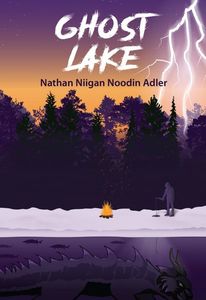"The History is Present in Each Moment" Nathan Niigan Noodin Adler on His Spectacular New Short Fiction Collection, Ghost Lake
Nathan Niigan Noodin Adler's 2016 novel Wrist was a taut, smart Indigenous monster story that launched Adler as a talented new literary voice. Readers are in for a treat with his follow up, Ghost Lake (Kegedonce Press), a story collection that acts as a companion volume to Wrist.
Exploring the blurred line between the past and the present through a fantastical swirl of stories covering everything from grave robbers to cryptid beasts and, of course, ghosts, Ghost Lake is further evidence of Adler's compelling, creative, thoughtful storytelling. He draws on Ojibwe cosmology to raise important questions about the way history shapes our daily lives and relationships, and to recognize the way memory is contained in our landscapes.
We're excited to welcome Nathan back to Open Book to discuss the stories in Ghost Lake as part of our short fiction-focused Keep It Short interview series. He tells us about coming to the short story form after writing a novel and how the two compare and contrast, about upending "the traditional horror narrative tropes of the Indian Burial Ground", and he shares a list of great short fiction to kick off your 2021 reading list.
Open Book:
How did you decide what stories to include in the collection? When were they written?
Nathan Niigan Noodin Adler:
I wrote a good majority of these stories a couple years after my novel Wrist came out with Kegedonce Press, after the work of promoting and doing readings slowed down. I had more time to dedicate to writing something new, but I didn’t feel up to the task of committing to a longer project like a novel. It felt too daunting.
I also thought it would be easier to set the stories within the same fictional story-world I created in Wrist. Why go to the trouble of imagining a new setting, a different urban-fantasy world with a different set of rules? I’d already done the work and gone through the process of imagining one. So yeah—I was being a bit lazy. But that’s how I came to these short stories.
At the time, I was also putting my application together to study Creative Writing at UBC, so I needed a portfolio of writing. Four of the stories in this collection were workshopped in class, and I learned a lot about building tension and stakes to keep readers engaged.
OB:
What do the stories have in common? Do you see a link between them, either structurally or thematically?
NNNA:
Structurally they are all told in present tense, and closely aligned with one character’s POV. Thematically, they all explore one character’s connection with the spirit world, or a spirit guide, or an encounter with a force of nature or something mysterious or inexplicable.
OB:
How did you decide which story would be the title story of your collection? Why that story in particular?
Your CanLit News
Subscribe to Open Book’s newsletter to get local book events, literary content, writing tips, and more in your inbox
NNNA:
I’ve always enjoyed reading short fiction, and had tried my hand at it, but this was the first time I really dived into the short story as a form, but the long-form of the novel still shadowed me. In many ways this collection feels more like an elaboration of Wrist, since all the characters are inter-related, and it is set in the same fictional world. Like placing a magnifying glass on different parts of the story-world, it has many similarities to a novel even though each of the stories have their own separate arcs. The collection is very much about place—so that’s the title of the collection Ghost Lake.
I’ve always loved the deep immersion that can happen with a long form novel, and some short story collections I’ve read can feel like you’re starting over again with each new story, so I also wanted this collection to maintain that sense of immersion, even if we jump into different POV’s—which is something a novel can do as well—there are jumps but the jumps aren’t far. Characters are always crossing each other’s paths, and living in the haunted shoes of all that happened in the past. The history is present in each moment.
I kept writing stories set in Ghost Lake, and if there were minor characters mentioned in one story, I’d think, hey these other characters probably have a back-story, so I’d have to write about them too. So the world kept getting bigger and more intricate and inter-related.
OB:
Do you think your characters have anything in common with each other, from story to story?
NNNA:
I think some of the characters came out of my approach to narrative, rather than the character determining the course of the plot, while other stories, the character came first and the story and narrative evolved out of that. So the stories were different in approach.
“Tyner’s Creek” and “Intermediaries” began specifically with a concept in mind; “Tyner’s Creek” jumps back into a pre-colonial era to tell a story that avoids the pitfall of referencing colonization, which can feel like it dominates Indigenous storytelling, so this was my way of moving away from that, and avoid getting bogged down in colonial trauma, even if it’s always present.
I also wanted to process the idea of living on land that has so much history that sometimes feels inaccessible given erasure of histories, of place names, and loss of knowledge, so I created an origin-story of sorts to fill in some of the blanks. And in "Intermediaries," I wanted to upend the traditional horror narrative tropes of the Indian Burial Ground, so I approached the story in a pretty methodical way, examining the trope, and how I could upend it, and tell that story differently, still working within that genre but from an Indigenous Horror perspective. Here the ghosts who are disturbed are very individual in their reactions, and their story is as central as those who cause harm by their actions. I had the themes and narratives I was set to deal with, and the story came out of the prompt I set for myself: three dead, three living, three objects and the connections between those things.
Similarly, “Hyrangeas” grew out of a desire to upend the script; the Indigenous women I know are not victims, they are strong, intelligent, funny, talented people doing amazing things, so I tried to write the sort of character I wanted to see, a badass Quentin-Tarantino-style strong female lead seeking vigilante justice—it was really about agency and power.
Others stories like “Incendiaries” really grew more organically, but began with the idea of this character with an unusual sexual predilection, (which I didn’t even know was a thing until after I’d written the rough draft and did a bit of research). I really wanted to explore the psychology of this guy, and how he came to be the way he is. So here the character determined the narrative structure rather than vice versa. We uncover his secrets and his past, working backwards through time to some of the possible factors shaping his sexuality.
OB:
Do you have a favourite short story collection that you've read? Tell us why it is special to you.
NNNA:
I’ve read many fantastic short story collections: Islands of Decolonial Love by Leanne Simpson, The Stone Collection by Kateri Akiwenzie-Damm, Wormwood by Poppy Z. Brite, Traplines by Eden Robinson, Lone Ranger and Tonto Fistfight in Heaven and The Business of Fancydancing by Alexi Sherman, Clive Barker’s Books of Blood. Godless but Loyal to Heaven by Richard Van Camp. The Grownup by Gillian Flynn (which is really just one long short story). Love After the End edited by Joshua Whitehead (which is an anthology of Indigi-queer and Two Spirit speculative fiction that I also have a short story in). And Bawaajigan ~ Stories of Power which is a dream-themed collection of short stories by Indigenous writers which I co-edited with Christine Miskonoodinkwe Smith.
______________________________________________
Nathan Niigan Noodin Adler is author of Wrist, (2016) and of Ghost Lake (2021). He is co-editor of Bawaajigan ~ Stories of Power, a dream-themed anthology of Indigenous writers (Exile Editions). He is an artist and filmmaker who works in a variety of mediums including audio & video, and drawing & painting. Nathan is first-place winner of an Aboriginal Writing Challenge, and recipient of a Hnatyshyn Reveal award for literature, he has an MFA in Creative Writing (UBC), BFA in Integrated Media (OCAD), and BA in English Literature & Native Studies (Trent). His writing is published in various magazines, blogs, and anthologies. He is two-spirit, Jewish, Anishinaabe, and member of Lac Des Mille Lacs First Nation. Originally from Ontario, he currently resides in Vancouver.






